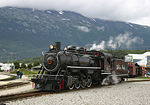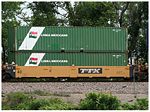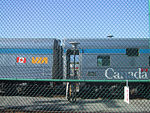Rail transport: Difference between revisions
imported>Howard C. Berkowitz No edit summary |
imported>Howard C. Berkowitz |
||
| Line 31: | Line 31: | ||
A [[funicular]] is a specialized kind of rail vehicle specially designed to climb steeper grades. They sometimes have a third rail, with gears. | A [[funicular]] is a specialized kind of rail vehicle specially designed to climb steeper grades. They sometimes have a third rail, with gears. | ||
===Track systems=== | |||
=== | ====Roadbed==== | ||
====Rails==== | |||
Gauge defines the spacing between the rails, and the dimensions of the rails themselves. | |||
Almost all railroads in North America, and Europe now use "[[standard guage]]" track, where the rails are 1,435 mm apart. Two exceptions are the [[Alaska Railway]], a narrow gauge heritage railway. It was originally built to transport treasure-seekers with the [[Klondike]] during the [[Klondike gold rush]]. The [[Toronto Transit Commission]] was designed to use a gauge slightly larger than standard gauge, so vehicles of the long distance railways could never use them. | Almost all railroads in North America, and Europe now use "[[standard guage]]" track, where the rails are 1,435 mm apart. Two exceptions are the [[Alaska Railway]], a narrow gauge heritage railway. It was originally built to transport treasure-seekers with the [[Klondike]] during the [[Klondike gold rush]]. The [[Toronto Transit Commission]] was designed to use a gauge slightly larger than standard gauge, so vehicles of the long distance railways could never use them. | ||
Railways using smaller [[narrow gauge]]s continue in use in [[Africa]], and various other regions. They can be cheaper to build. They often travel at slower speeds, on track laid out with less precision, and with more lightly constructed railbeds. Consequently they can carry lighter cargo loads. | Railways using smaller [[narrow gauge]]s continue in use in [[Africa]], and various other regions. They can be cheaper to build. They often travel at slower speeds, on track laid out with less precision, and with more lightly constructed railbeds. Consequently they can carry lighter cargo loads. | ||
Trains in the former [[Soviet Union]] and several other use a larger [[broad gauge]]. | Trains in the former [[Soviet Union]] and several other use a larger [[broad gauge]]. | ||
A [[break of gauge]] is the intersection of railway networks with different gauges. Different mechanisms are used to deal with a break of gauge: | A [[break of gauge]] is the intersection of railway networks with different gauges. Different mechanisms are used to deal with a break of gauge: | ||
| Line 54: | Line 50: | ||
===Rolling stock=== | ===Rolling stock=== | ||
Railroads employ a variety of specialized vehicles | Railroads employ a variety of specialized vehicles. Conventional railroads use [[#locomotives]] to pull (or sometimes push) unpowered cars. Some modern systems have powered cars, or complex car-track interaction systems such as [[magnetic levitation]]. | ||
====Locomotives==== | |||
Locomotives apply the mechanical energy required to move the other, unpowered cars of a train. The first were steam-propelled, and a [[coal tender]] to carry the fuel that fired their engines, as well as water supplies along the routes. Most conventional locomotives are diesel-electric, or use electric power from an external source. | |||
{{Image|Alaska Railroad Locomotive.jpg|right|150px| Steam locomotive, Skagway, Alaska}} | {{Image|Alaska Railroad Locomotive.jpg|right|150px| Steam locomotive, Skagway, Alaska}} | ||
====Caboose==== | |||
The [[caboose]], (alternatively guard van) was a small car where the [[conductor (rail)|conductor]] would have his office. Typically the caboose was the last vehicle in the train, and staff on board the caboose would observe the rest of the train for problems. | The [[caboose]], (alternatively guard van) was a small car where the [[conductor (rail)|conductor]] would have his office. Typically the caboose was the last vehicle in the train, and staff on board the caboose would observe the rest of the train for problems. | ||
====Boxcar==== | |||
[[Boxcar]]s are enclosed vehicles used to carry cargo. Variants may be refrigerated, be ventilated to carry livestock, etc. | |||
====Flatcar==== | |||
[[Flatcar]]s are unenclosed vehicles that carry [[intermodal container]]s, large machinery, coils of metal, bails of wire. | [[Flatcar]]s are unenclosed vehicles that carry [[intermodal container]]s, large machinery, coils of metal, bails of wire. | ||
{{Image|Intermodal shipping containers on a railway flat car.jpg|left|150px| Intermodal shipping containers on a railway flat car}} | |||
{{Image|Intermodal shipping containers on a railway flat car.jpg| | ====Hopper car==== | ||
[[Hopper car]]s, also called godolas, are open-topped vehicles used to transport bulk material like coal or ore. They are loaded from the top and usually unloaded through trapdoors in their bottoms. | |||
[[Hopper car]]s are open-topped vehicles used to transport bulk material like coal or ore. They are loaded from the top and usually unloaded through trapdoors in their bottoms. | |||
{{Image|Skol hopper car.jpg|right|150px| Hopper car - note unloading trap doors}} | {{Image|Skol hopper car.jpg|right|150px| Hopper car - note unloading trap doors}} | ||
====Passenger car==== | |||
[[Passenger car (rail)|Passenger car]] are vehicles with seats for carrying passengers. Some long distance passenger cars have small rooms with beds for overnight trips. Some modern passenger cars are two stories tall. | [[Passenger car (rail)|Passenger car]] are vehicles with seats for carrying passengers. Some long distance passenger cars have small rooms with beds for overnight trips. Some modern passenger cars are two stories tall. | ||
{{Image|Canadian passenger rail cars.jpg|left|150px| Canadian passenger cars}} | |||
{{Image|Canadian passenger rail cars.jpg| | ====Tank car==== | ||
====Rail car==== | |||
A [[rail car]] self-powered vehicles, equipped as a passenger car, capable of providing limited service on less-traveled routes. | A [[rail car]] self-powered vehicles, equipped as a passenger car, capable of providing limited service on less-traveled routes. | ||
Revision as of 15:49, 5 August 2009
A railroad (American English) or railway (British English) is a system for transporting passengers, or cargo, where the vehicles run on networks of fixed rails.
History
The first railways were built in the United Kingdom, and were powered by steam. Steam railroads are still in use in some countries with older rolling stock, or on heritage lines that transport tourists.
Typically railway vehicles are connected together in "trains". Traditionally the leading (sometimes trailing) vehicle, or vehicles, is a locomotive, the vehicle with the engine that powers the whole train. However, on modern trains each carriage is identical and can stand alone or at any point in the train.
In the twentieth century diesel, or diesel-electric started to replace steam engines for long-range use.
Various kinds of shorter range commuter trains, subways, underground, metro, trams, streetcars, trolleys, light rail vehicles are almost always electrically powered. In some regions intercity trains are also electrically powered.
Economics
At the present time, railroads are most effective as a means of carrying large amounts of cargo. In less developed areas, they may be very viable alternatives to highway construction for individual transportation, and they also, as in England, are attractive alternatives to short-haul air transport. Specialized railroads can be critical parts of urban mass transportation systems.
For long-distance passenger transport, however, airlines have displaced rail travel in many areas.
Technology
For most of the history of rail transportation the vehicles traveled on parallel pairs of steel rails. The rails are attached to sleepers, which rigidly hold the rails at a fixed distance from one another. The sleepers, in turn, rest on specially prepared beds, often of gravel, which prevent the great weight of the train from sinking into the ground.
The speed at which a train can travel depends on the effort and precision into laying out the track. Very high speed trains run on track laid out with more precision, with more gentle curves. The track on curves is often gently banked.
The wheels rail vehicles travel on have a large inner flange, that rests inside the rails. Because the pairs of wheels on either track are connected with a fixed axle the surface of the wheels that makes contact with the rails are very slightly conical. This allows the vehicles to round curves more easily. When rounding a curve the inner wheel traverses a slightly shorter path than the outer wheel. If the rolling surface of the wheels was of a constant diameter one of the two wheels would have to wastefully and ineffeciently slip. However, the conical rolling surface allow the inner wheel a curve in the track's path to roll on a cross-section of the wheel with a slightly smaller diameter than the cross-section the outer wheel is rolling on.
The tracks are also designed to avoid rapid changes of grade. Rises of more than 2 percent can be dangerous, and require extra locomotives.
To avoid dangerous grade changes railways often employ tunnels through mountains. Tunnels are extremely expensive to construct. The route the Canadian Pacific Railway employs to cross Kicking Horse Pass uses spiral tunnels to circumvent an older route that had a section with a dangerously steep slope.
A funicular is a specialized kind of rail vehicle specially designed to climb steeper grades. They sometimes have a third rail, with gears.
Track systems
Roadbed
Rails
Gauge defines the spacing between the rails, and the dimensions of the rails themselves.
Almost all railroads in North America, and Europe now use "standard guage" track, where the rails are 1,435 mm apart. Two exceptions are the Alaska Railway, a narrow gauge heritage railway. It was originally built to transport treasure-seekers with the Klondike during the Klondike gold rush. The Toronto Transit Commission was designed to use a gauge slightly larger than standard gauge, so vehicles of the long distance railways could never use them.
Railways using smaller narrow gauges continue in use in Africa, and various other regions. They can be cheaper to build. They often travel at slower speeds, on track laid out with less precision, and with more lightly constructed railbeds. Consequently they can carry lighter cargo loads.
Trains in the former Soviet Union and several other use a larger broad gauge.
A break of gauge is the intersection of railway networks with different gauges. Different mechanisms are used to deal with a break of gauge:
- cargo can be manually transferred to new rolling stock;
- the bogey, the portion of the vehicles with the wheels and their axles, is interchanged with one of the appropriate gauge;
- each of the bogeys on each vehicle can be rolled over, and lifted on a rolling block.
- a third rail, or another pair of rails, can be added to each sleeper, so trains of either gauge can travel on the same railbed.
Rolling stock
Railroads employ a variety of specialized vehicles. Conventional railroads use #locomotives to pull (or sometimes push) unpowered cars. Some modern systems have powered cars, or complex car-track interaction systems such as magnetic levitation.
Locomotives
Locomotives apply the mechanical energy required to move the other, unpowered cars of a train. The first were steam-propelled, and a coal tender to carry the fuel that fired their engines, as well as water supplies along the routes. Most conventional locomotives are diesel-electric, or use electric power from an external source.
Caboose
The caboose, (alternatively guard van) was a small car where the conductor would have his office. Typically the caboose was the last vehicle in the train, and staff on board the caboose would observe the rest of the train for problems.
Boxcar
Boxcars are enclosed vehicles used to carry cargo. Variants may be refrigerated, be ventilated to carry livestock, etc.
Flatcar
Flatcars are unenclosed vehicles that carry intermodal containers, large machinery, coils of metal, bails of wire.
Hopper car
Hopper cars, also called godolas, are open-topped vehicles used to transport bulk material like coal or ore. They are loaded from the top and usually unloaded through trapdoors in their bottoms.
Passenger car
Passenger car are vehicles with seats for carrying passengers. Some long distance passenger cars have small rooms with beds for overnight trips. Some modern passenger cars are two stories tall.
Tank car
Rail car
A rail car self-powered vehicles, equipped as a passenger car, capable of providing limited service on less-traveled routes.



